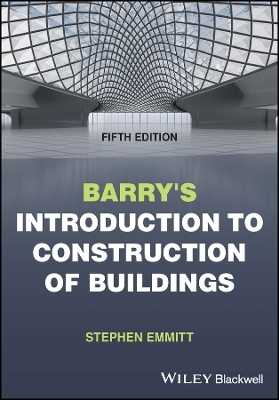
Barry's Introduction to Construction of Buildings
Wiley-Blackwell (Verlag)
978-1-119-73099-6 (ISBN)
Barry’s Introduction to Construction of Buildings provides the basic material an undergraduate student will need to understand how the majority of low-rise buildings are constructed. The text explains construction technology through key functional and performance requirements for the main elements common to all buildings. The material in the Fifth Edition has been updated to ensure it covers the latest building regulations and current construction technology, with particular attention paid to the decisions required on what and how to build to achieve a low carbon, resilient built environment. Design, technology, site assembly, and environmental issues are all covered, showing how buildings that are more efficient, with lower embodied carbon, are constructed. New ‘in chapter’ questions better facilitate self-reflection and learning.
Barry’s Introduction to Construction of Buildings contains information on:
General principles of construction, regulations and approvals, making choices and sources of information, and responding to climate change
Site analysis, setup, security, bedrock and soil types, ground stability, drainage, strip, pad, and raft foundations and scaffolding
Functional requirements for floors, including ground-supported concrete floor slabs, timber upper floors, floor finishes, and suspended timber ground floors
Pitched roofs and their coverings, sheet metal covering to low-pitched roofs, flat roofs, thermal insulation in flat roofs, parapet walls, and green roofs
Barry’s Introduction to Construction of Buildings is an ideal learning resource for undergraduate students and those working towards similar NQF level 5 and 6 qualifications in building and construction. This title is a companion to Barry’s Advanced Construction of Buildings.
Stephen Emmitt, PhD is Professor of Architectural Practice at the Department of Architecture and Civil Engineering, University of Bath, UK. He is an architect with industrial experience.
How to Navigate this Book ix 1 Introduction 1
1.1 Towards a decarbonised built environment 1
1.2 Responding to climate change 2
1.3 The function and performance of buildings 3
1.4 General principles of construction 6
1.5 Regulations and approvals 11
1.6 Sources of information 13
Further reading 13
Chapter 2 AT A GLANCE 15
2 Site Analysis, Set-Up, Drainage, and Scaffolding 17
2.1 Site analysis 17
2.2 Site set-up and security 30
2.3 Site drainage 34
2.4 Foul drainage 41
2.5 Scaffolding 68
Further reading 88
Reflective exercises 88
Chapter 3 AT A GLANCE 89
3 Ground Stability and Foundations 91
3.1 Bedrock and soil types 91
3.2 Ground stability 98
3.3 Foundations: functional requirements 101
3.4 Foundation construction 113
3.5 Strip foundations 124
3.6 Pad foundations 134
3.7 Raft foundations 143
3.8 Short-bored pile foundations 151
3.9 Precast pile and beam foundation systems 153
Further reading 155
Reflective exercises 155
Chapter 4 AT A GLANCE 157
4 Floors 159
4.1 Functional requirements 159
4.2 Ground-supported concrete floor slab 162
4.3 Suspended concrete floor slabs 170
4.4 Suspended timber ground floors 176
4.5 Reinforced concrete upper floors 179
4.6 Timber upper floors 182
4.7 Floor finishes 190
Further reading 200
Reflective exercises 200
Chapter 5 AT A GLANCE 201
5 Loadbearing Walls 203
5.1 Functional requirements 203
5.2 Walling materials 210
5.3 Mortar 221
5.4 Bonding bricks and blocks 226
5.5 Damp-proof courses (DPCs) 231
5.6 Solid wall construction 239
5.7 Cavity wall construction 269
5.8 Internal and party walls 291
5.9 Straw wall construction 294
5.10 Earth wall construction 300
5.11 Green (living) walls 304
Further reading 305
Reflective exercises 305
Chapter 6 AT A GLANCE 307
6 Roofs 309
6.1 Functional requirements 309
6.2 Pitched roofs 313
6.3 Pitched roof coverings 328
6.4 Sheet metal covering to low-pitched roofs 351
6.5 Thermal insulation to pitched roofs 354
6.6 Flat roofs 359
6.7 Timber flat roof construction 362
6.8 Concrete flat roofs 378
6.9 Thermal insulation to flat roofs 381
6.10 Parapet walls 385
6.11 Green roofs 390
6.12 Roof drainage 394
Further reading 401
Reflective exercises 401
Chapter 7 AT A GLANCE 403
7 Windows 405
7.1 Functional requirements 405
7.2 Window types 430
7.3 Window frames 439
7.4 Glass and glazing 463
7.5 Hardware 481
7.6 Window cills 483
Further reading 490
Reflective exercises 490
Chapter 8 AT A GLANCE 491
8 Doors 493
8.1 Functional requirements 493
8.2 Door types 498
8.3 Door frames and linings 519
8.4 Hardware 535
Further reading 541
Reflective exercises 541
Chapter 9 AT A GLANCE 543
9 Stairs and Ramps 545
9.1 Functional requirements 545
9.2 Terms, definitions and materials 548
9.3 Types of stairs 557
9.4 Timber staircases 560
9.5 Stone stairs 571
9.6 Reinforced concrete stairs 571
9.7 Structural glass stairs 576
9.8 Ramps 576
Further reading 579
Reflective exercises 579
Chapter 10 AT A GLANCE 581
10 Surface Finishes 583
10.1 Functional requirements 583
10.2 Wall and ceiling finishes 585
10.3 Skirtings, architraves, and kitchen cabinets 600
10.4 Tiling to walls 604
10.5 Painting and decorating 605
Further reading 612
Reflective exercises 612
Chapter 11 AT A GLANCE 613
11 Internal Environment and Energy Supply 615
11.1 Principles and performance requirements 615
11.2 Heat loss calculations 617
11.3 Testing and monitoring thermal performance 626
11.4 Indoor climate control 629
11.5 Energy sources 634
11.6 Solid fuel-burning appliances 640
11.7 Domestic electrical supply and installations 655
11.8 Artificial lighting 677
Further reading 679
Reflective exercises 679
Chapter 12 AT A GLANCE 681
12 Water Supply and Sanitation 683
12.1 Cold water supply and distribution 683
12.2 Hot water supply and distribution 693
12.3 Water services to multi-storey buildings 699
12.4 Pipes for water supply 708
12.5 Sanitary appliances 712
Further reading 733
Reflective exercises 734
Index 735
| Erscheinungsdatum | 23.09.2023 |
|---|---|
| Verlagsort | Hoboken |
| Sprache | englisch |
| Maße | 170 x 244 mm |
| Gewicht | 1276 g |
| Themenwelt | Technik ► Bauwesen |
| ISBN-10 | 1-119-73099-6 / 1119730996 |
| ISBN-13 | 978-1-119-73099-6 / 9781119730996 |
| Zustand | Neuware |
| Informationen gemäß Produktsicherheitsverordnung (GPSR) | |
| Haben Sie eine Frage zum Produkt? |
aus dem Bereich



